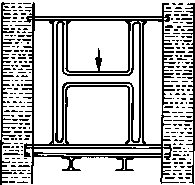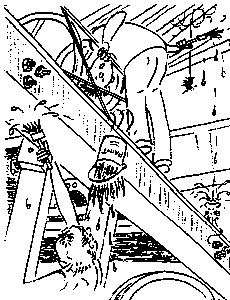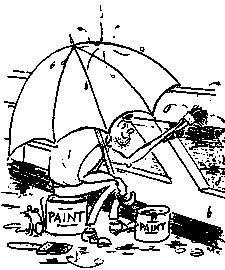
Timber frame

Low sided metal A frame

Metal H frame
The Tower Handbook
No. Frames are made of either timber or metal. Most, but not all, new frames tend to be metal, whereas older frames are generally timber, usually oak. Sometimes a timber frame has an extension made of metal. There are many different patterns of frame, both timber and metal. There are no major disadvantages to either type of frame, but maintenance requirements are rather different, primarily nut-tightening for timber and rust prevention for metal. Cast iron frames are less prone to corrosion than steel ones, but they are rather more expensive in the first place.
Remember to keep the bell chamber free of rubbish – birds' nests, old bits of rope and so on. Debris around the base of any type of frame holds moisture and encourages the frame to rust or rot. It is messy too.
Common patterns of bell frame (The arrows show where the bearings sit)
 Timber frame |
 Low sided metal A frame |
 Metal H frame |
A steel or cast iron frame should not need regular bolt tightening like a timber one, but it can rust. Painting a metal frame only needs doing infrequently, but can be a big job when it has to be done, especially if the frame has many awkward corners and crevices. If you leave it too long before repainting, you will have a lot more work to remove the accumulated rust.
Probably at least 10 years, but so much depends on the structure of the tower and its location. A frame in a church on a cliff top in Devon, or one surrounded by trees in the middle of a country park, could well need attention within five years. If you touch up odd spots of rust as they occur you could probably stave off the full repainting job for 20 years or more.
There is no simple answer. It depends on how big and complicated the frame is, how easy it is to get at, and how rusty, dirty or greasy it is. It also depends on how many of you there are, how fast you work and what sort of paint you use. Weigh up these factors, estimate the total area and try to produce an objective assessment of the time it will take before you start. Don't be surprised if it takes several people several days of hard work.
 The worst part is cleaning down. There can be a lot of dust from accumulated dirt and rust; use vacuums instead of brushes where possible and wear dust masks. Even so you will still go home with a nasty taste in your mouth.
The worst part is cleaning down. There can be a lot of dust from accumulated dirt and rust; use vacuums instead of brushes where possible and wear dust masks. Even so you will still go home with a nasty taste in your mouth.
Be careful climbing over the frame, especially since you may be climbing over someone else, and take especial care not to scrape, sweep or paint directly above anyone.
Keep the bell chamber ventilated both when cleaning and when painting. This is not usually a problem, but worth bearing in mind. Many belfries have plenty of ventilation, but if the air is still, you can often increase ventilation by leaving doors open below to allow fresh air up the stairs. If you have sound control shutters you should of course open them.
 When painting, start at the top of the pit furthest from the exit and work down the frame towards the door. Be careful not to leave yourself in a position where you have to clamber over fresh paint.
When painting, start at the top of the pit furthest from the exit and work down the frame towards the door. Be careful not to leave yourself in a position where you have to clamber over fresh paint.
A rust inhibiting primer is OK for just touching up the odd rusty patch, but do clean off loose rust first. For the whole job you should really use a rust inhibiting primer followed by an undercoat and top coat. Alternatively you can use Hammerite or Smoothrite. They are one-coat metal paints designed for structural steelwork. Sometimes you may need a second coat, but before adding one be sure to read the instructions carefully, since it has to be applied either within a few hours or after a lapse of some six weeks.
These paints will cost rather more than traditional stuff, but will save a lot of time. You need to be rather more diligent with your cleaning down, but then you can just slap on the first (or only) coat. Be very careful not to splash the stuff about, and avoid getting it on your skin, since it's the very devil to get off. If you splash it on your overalls, don't be surprised if it soaks through to the clothes underneath since it is thin and runny. Always check with your supplier that the paints you've chosen are suitable.
Before painting it's a good idea to mask off bells, wheels and so on with sheets of newspaper so that you don't get paint on them. This is particularly true if you're using Hammerite or Smoothrite. Bells with splatterings of paint on them are not aesthetically pleasing and the evidence of your untidy handiwork could be around for the next century!
Generally speaking, no. If you find signs of active woodworm or beetle attack (fortunately fairly rare) you should seek professional advice. Do not attempt treatment yourself. It is a specialist job and there are stringent regulations about the type of preservatives you may use if there might be bats in the vicinity. You must have a survey to find out whether there are any bats in the belfry. See section 14.12g.
Keep nuts, tie rods and metal parts on a timber frame painted and rust-free.
About every six months is reasonable but this may depend on your particular installation. The important time to check tightness is after a spell of dry weather, since timbers tend to shrink then, and you will be able to make a better job of it.
 Spanners for bigger nuts have longer handles to give more leverage. They are designed so a person of average strength can apply enough force, but will be unable to apply too much. So it's safe to assume that you can't over tighten.
Spanners for bigger nuts have longer handles to give more leverage. They are designed so a person of average strength can apply enough force, but will be unable to apply too much. So it's safe to assume that you can't over tighten.
Do not use lengths of pipe on the spanner to give extra leverage since then you will be able to apply more than the spanner and nut are designed to take.
If you can't tighten the nut any more but there still seems to be some play at the nut end, it's worth checking to see whether you've run out of thread. If so you could fit a metal washer between the nut and the frame.
Not usually, but if you're worried about them digging into the timber, remove the nut and put a metal washer between it and the frame. There should be one there already.
Absolutely No. Get some advice. See section 14.12h.
Currently hosted on jaharrison.me.uk